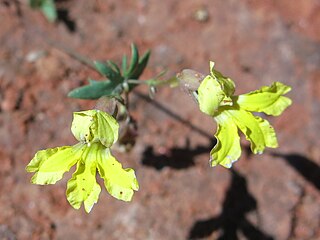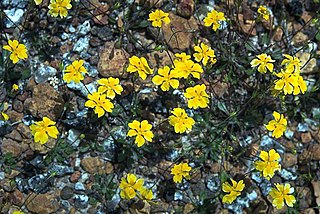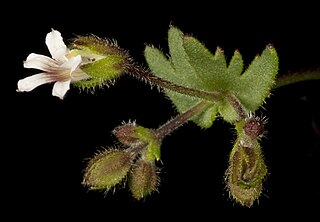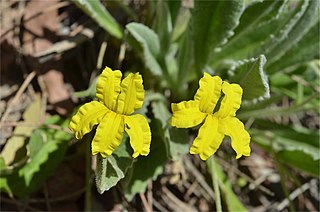Velleia is a historically recognised genus of about 30 species of herbs in the family Goodeniaceae.

Goodenia caroliniana is a species of flowering plant in the family Goodeniaceae, and is endemic to eastern Australia. It is a perennial herb with egg-shaped to lance-shaped leaves with toothed edges and the narrower end toward the base, and erect flowering stems up to 50 cm (20 in) high and yellow flowers.

Goodenia connata, commonly known as cup velleia, is a species of flowering plant in the family Goodeniaceae, and is found in all mainland states and territories of Australia. It is a glabrous annual herb with a rosette of leaves at the base, and ascending flowering stems with yellow, brownish-yellow or white flowers, often with mauve markings.

Goodenia glabrata, commonly known as pee the bed, is a species of flowering plant in the family Goodeniaceae and is native to mainland Australia. It is a mostly glabrous annual herb with ascending flowering stems, oblong to lance-shaped leaves with toothed edges, and yellow flowers.

Goodenia arthrotricha is a species of flowering plant in the family Goodeniaceae and endemic to south-western Western Australia. It is an erect perennial, herb with linear to lance-shaped leaves with the narrower end towards the base, racemes of blue flowers with linear bracteoles at the base, and oval fruit.

Goodenia benthamiana, commonly known as small-leaf goodenia, is a species of flowering plant in the family Goodeniaceae and is endemic to south-eastern Australia. It is an aromatic undershrub with stem-clasping, egg-shaped to elliptic leaves with toothed edges, and yellow flowers arranged singly or in groups of up to three in leaf axils, with leaf-like bracteoles at the base.
Goodenia bicolor is a species of flowering plant in the family Goodeniaceae and is endemic to north-western Australia. It is an annual or ephemeral herb with lance-shaped to egg-shaped leaves with the narrower end towards the base, racemes of yellow or yellow and purple flowers and elliptical fruit.
Goodenia brachypoda is a species of flowering plant in the family Goodeniaceae and is endemic to northern Australia. It is a low-lying to upright herb with narrow elliptic to oblong leaves, racemes of yellow flowers with leaf-like bracts at the base, and more or less spherical fruit.

Goodenia claytoniacea is a species of flowering plant in the family Goodeniaceae and is endemic to the south-west of Western Australia. It is an annual herb with lance-shaped leaves mostly at the base of the plant, yellow flowers arranged singly or in small groups, and oval fruit.
Goodenia cusackiana is a species of flowering plant in the family Goodeniaceae and is endemic to the north-west of Western Australia. It an erect herb, densely covered with silvery hairs and has a woody stem, narrow elliptic to lance-shaped leaves, and racemes of yellow flowers.

Goodenia cycnopotamica is a species of flowering plant in the Goodeniaceae family and is endemic to Australia, found in both South Australia and Western Australia. It is an annual herb with oblong to lance-shaped leaves and pink or lilac to white flowers.

Goodenia fasciculata is a species of flowering plant in the family Goodeniaceae and is endemic to the south-west of Western Australia. It an ascending shrub with bunched, narrow linear stem leaves and spikes of white flowers.
Goodenia leptoclada, commonly known as thin-stemmed goodenia, is a species of flowering plant in the family Goodeniaceae and is endemic to the extreme south-west of Western Australia. It is an ascending perennial herb with lance-shaped to egg-shaped leaves with the narrower end towards the base and racemes of blue flowers.
Goodenia macroplectra is a species of flowering plant in the family Goodeniaceae and is endemic to inland Western Australia. It an erect herb with toothed, lance-shaped leaves at the base of the plant, and racemes of dark yellow flowers with a long spur.

Goodenia robusta, commonly known as woolly goodenia, is a species of flowering plant in the family Goodeniaceae and is endemic to southern Australia. It is an erect or ascending perennial herb with crowded, hairy, elliptic to narrow oblong leaves at the base of the plant, and racemes of yellow flowers.
Goodenia salmoniana is a species of flowering plant in the family Goodeniaceae and only known from the type specimen collected in Western Australia in 1889. It an erect to ascending herb, with linear leaves and racemes of dark yellow flowers.

Goodenia sepalosa is a species of flowering plant in the family Goodeniaceae and is endemic to northern Australia. It is a prostrate to ascending herb with narrow oblong to lance-shaped leaves, the narrower end towards the base, and racemes of yellow flowers.
Goodenia trichophylla is a species of flowering plant in the family Goodeniaceae and is endemic to the southwest of Western Australia. It is an erect to ascending herb with sticky or shiny, linear leaves at the base of the plant and racemes of blue flowers.

Goodenia daviesii, commonly known as hairy velleia, is a species of flowering plant in the Goodeniaceae family and is endemic to inland areas of Western Australia. It is an annual herb with lyre-shaped, pinnatifid leaves and lilac to white flowers.

Goodenia discophora, commonly known as cabbage poison, is a species of flowering plant in the Goodeniaceae family and is endemic to the south-west of Western Australia. It is a herb with lyre-shaped, pinnatifid leaves and yellow flowers.














